Silage and pugged paddocks
When harvesting silage from pugged paddocks you should consider:
- the roughness of the ground and its effects on equipment and the operators
- reduced yields and lower quality pasture due to weeds and it usually being cut later.
Another consideration is electric fence posts which can be lost in the mud. These can damage machinery and delay your crop harvest. Even plastic or fibre glass electric fence posts have a high tensile tip which is very hard to cut.
Principles to consider when ensiling on pugged paddocks
Silage fermentation is badly affected by mud and dust
Mud and dust bring undesirable bacteria into the silage stack or bale and can cause poor fermentation (Figure 1). This will result in high losses of dry matter and nutritive value of the silage as well as low palatability. To minimise soil and dust inclusion, mow slightly higher, being very careful with tedding, raking and harvester or baler pick-up heights.
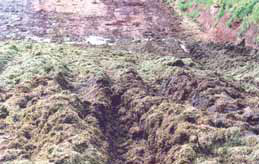
Silage additives
Although not a guarantee of success, the use of fermentation enhancing-type silage additives is highly recommended. Bacterial inoculants are a major group in this type of additive, but there are other products that achieve similar outcomes. Adding a desirable lactic acid-producing bacteria (fermentation enhancing inoculants) will help to compete against the spoilage bacteria in the mud, dirt and dust that will inevitably be picked up by tynes during raking, forage harvesting or baling in pugged paddocks.
If poor wilting conditions (cool, overcast weather) persist, the material being ensiled may be slightly under the optimal 30 per cent dry matter for forage harvested silage, or under 40 per cent for baled silage. In this case, silage additives will increase the likelihood of a more favourable fermentation.
Be aware that the additive application rate is based on a fresh weight basis. That is, higher rates of additive will have to be applied than if the material was harvested at the recommended dry matter contents. You will need to accurately determine the throughput of your harvesting machinery to apply the correct rates. Avoid short-changing on the amount of additive per tonne of crop.
Wilting rate
To speed the rate of wilting, use a tedder (Figure 2) as soon as possible after mowing, and possibly again the next morning, after the dew has lifted. Try to avoid incorporating too much dirt into the forage by setting tynes to clear pug marks. A flail-type mower conditioner with swath boards left as wide as possible will also increase the wilting rate, although at a reduced rate compared to a tedder.
Try to keep to the cleaner areas of the paddock. Avoid low-lying, wet or muddy areas as these act as 'bad' inoculants, affecting much of the stack or bale.
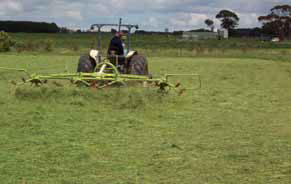
Pasture quality
Pasture quality is integral. The higher the pasture quality is at silage harvest, the better the animal performance when fed the silage. The regrowth of the pasture after harvest will also be better.
In spring, pasture quality will start deteriorating once pastures approach canopy closure. The growth stage at silage making could be anywhere from the two to three leaf stage of the ryegrasses where the first leaf will begin dying very quickly in spring once the fourth leaf starts to appear. If the plants are still in the vegetative stage, as later maturing ryegrass varieties may be, then the drop in nutritive value will be relatively slow.
However, if sunlight does not reach the pasture base, the generation of new tillers will be reduced and death of young tillers will occur. This will result in pastures of lower density and ultimately in lower annual pasture production.
If pastures are starting to send up reproductive tillers — the stems that contain seed heads — canopy closure will be reached more quickly causing these problems. More importantly, pastures at this stage decrease in nutritive value much more rapidly than those in the vegetative stage.
Paddock choice
Are there 'less wet' paddocks that can be ensiled, using the wetter paddocks for grazing?
There may be a window where the low lying paddocks can be grazed, with little pugging damage by now, on a fast rotation and then grazed quickly again. This will slow pasture regrowth and reduce pasture mass but provide some feed now and may allow them to be harvested later.
Due to a quicker grazing in these paddocks, they may have higher residuals and may need to be post-graze topped when conditions suit, if they are not ensiled. They will be of lower quality. Pre-graze topping may be another option but remember that milk production may drop somewhat as the animals won't be able to select and will consume the good, the bad and the fouled.
Silage harvesting recommendations for various levels of pugging damage
Severe damage
Paddocks will have deep (greater than 5cm) pug marks, some pasture may have been buried and is now rotting, and some of the grass will still have mud and manure on the leaves. Try to judge the density of the remaining pasture.
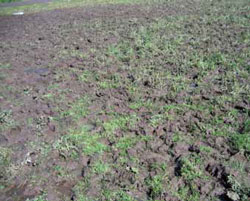
- Avoid ensiling these areas, assuming soils have dried enough to allow vehicle access without leaving deep ruts. Instead, earmark these pastures for summer cropping or spring sowing with Italian or perennial ryegrass as soon as practical.
Medium damage
Paddocks will have medium (2 to 5cm) depth pug marks, little pasture buried and most of the fouled grass will have been washed by follow-up rains. If mowing, tedding, raking and harvesting can be done with minimal soil (dust or mud) inclusion, then silage should be a possibility. This depends when you can get machinery onto the paddocks without causing too much damage.
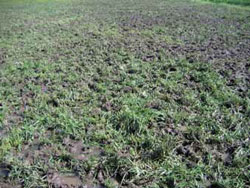
- If the paddock is tractable and not too rough, then ensiling is possible. Remember to minimise mowing the clump tops (dirt, poor quality plant material) and minimise dirt and dust pick up at tedding and harvesting. Consider using an additive.
Minimal damage
These paddocks will have shallow (less than 2cm) pug marks and should be viewed as 'business as usual'. The main concern here will be the nutritive value of the pasture or silage. The earlier it is cut, the better its value.
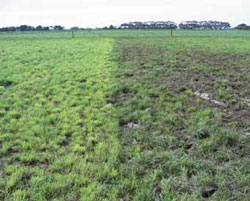
- Assuming the paddocks can be harvested without soil damage, follow the normal silage-making practices.
- Given that wilting and soil moisture conditions may affect wilting rate, consider using an additive.
Acknowledgements
This information was originally written by Frank Mickan, Ellinbank.
July 2011.